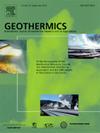Updated conceptual model of the hydrothermal system in the Acoculco Caldera, Mexico
IF 3.5
2区 工程技术
Q3 ENERGY & FUELS
引用次数: 0
Abstract
The Acoculco Caldera hosts a high-temperature geothermal system that has not been exploited due to the lack of permeability revealed by the deep exploration wells. Results of our detailed geological and geochemical exploration, integrated with previous results of electric and electromagnetic surveys, have shown large differences in the structures and hydrothermal activity between the northern and southern parts of the Caldera. Electromagnetic surveys indicate the presence of a large high conductivity anomaly towards the north of the caldera and very high resistivity where the deep wells were drilled, which is probably related to the intense silicification observed in the core samples from the deep wells. These disparities are enhanced by the presence of thermal springs and recent volcanics in the northern part, in addition to intense hydrothermal alteration and extremely high heat flow measured in shallow geothermal gradient wells drilled in the northern part of the caldera. Geochemistry of the thermal springs on the northern border of the Caldera is consistent with a hydrothermal reservoir with temperatures close to 300 °C. The Curie Point Depth (CPD) calculation yields a value 7 km that can be correlated with the geothermal gradient measured in the deep exploration wells only if convection is assumed in a layer at least 1 km thick. All this evidence suggests that a viable reservoir may be present at depth in the northern section of the Acoculco Caldera.
墨西哥acococo火山口热液系统的更新概念模型
acococco火山口拥有一个高温地热系统,由于深探井显示的渗透率不足,该系统尚未被开发。我们详细的地质和地球化学勘探结果,结合以往的电和电磁调查结果,表明了火山口北部和南部在结构和热液活动方面的巨大差异。电磁测量表明,火山口北部存在一个大的高电导率异常,深井钻孔处的电阻率非常高,这可能与深井岩心样品中观察到的强烈硅化有关。除了在火山口北部钻探的浅地热梯度井中测量到的强烈的热液蚀变和极高的热流外,北部地区存在的温泉和最近的火山活动也增强了这种差异。火山口北部边界温泉的地球化学特征与温度接近300℃的热液储层相一致。居里点深度(Curie Point Depth, CPD)计算得到的值为7km,只有假设在至少1km厚的地层中存在对流,该值才能与深探井测得的地热梯度相关联。所有这些证据都表明,在阿库尔科火山口北部的深处可能存在一个可行的储层。
本文章由计算机程序翻译,如有差异,请以英文原文为准。
求助全文
约1分钟内获得全文
求助全文
来源期刊

Geothermics
工程技术-地球科学综合
CiteScore
7.70
自引率
15.40%
发文量
237
审稿时长
4.5 months
期刊介绍:
Geothermics is an international journal devoted to the research and development of geothermal energy. The International Board of Editors of Geothermics, which comprises specialists in the various aspects of geothermal resources, exploration and development, guarantees the balanced, comprehensive view of scientific and technological developments in this promising energy field.
It promulgates the state of the art and science of geothermal energy, its exploration and exploitation through a regular exchange of information from all parts of the world. The journal publishes articles dealing with the theory, exploration techniques and all aspects of the utilization of geothermal resources. Geothermics serves as the scientific house, or exchange medium, through which the growing community of geothermal specialists can provide and receive information.
 求助内容:
求助内容: 应助结果提醒方式:
应助结果提醒方式:


